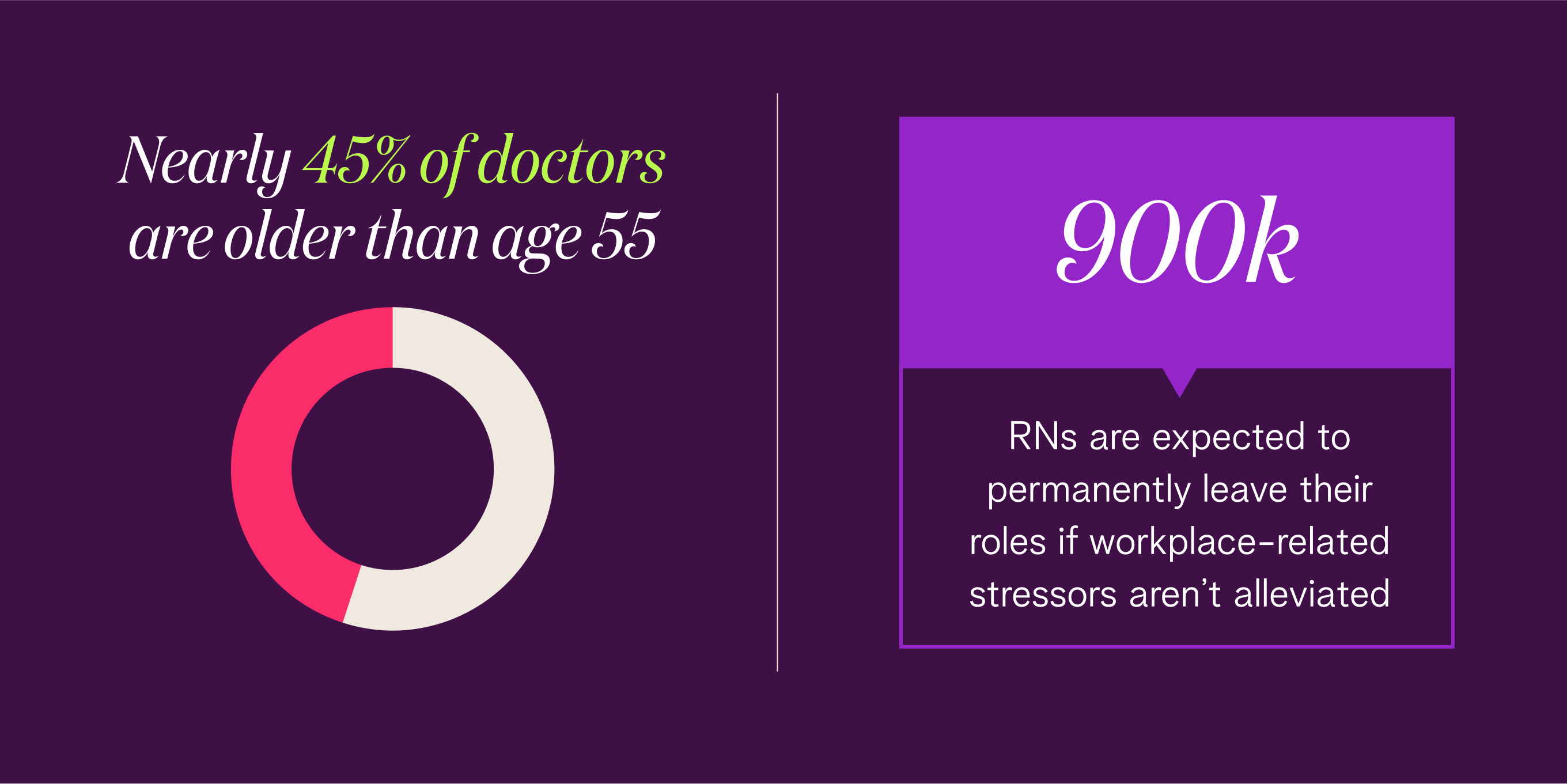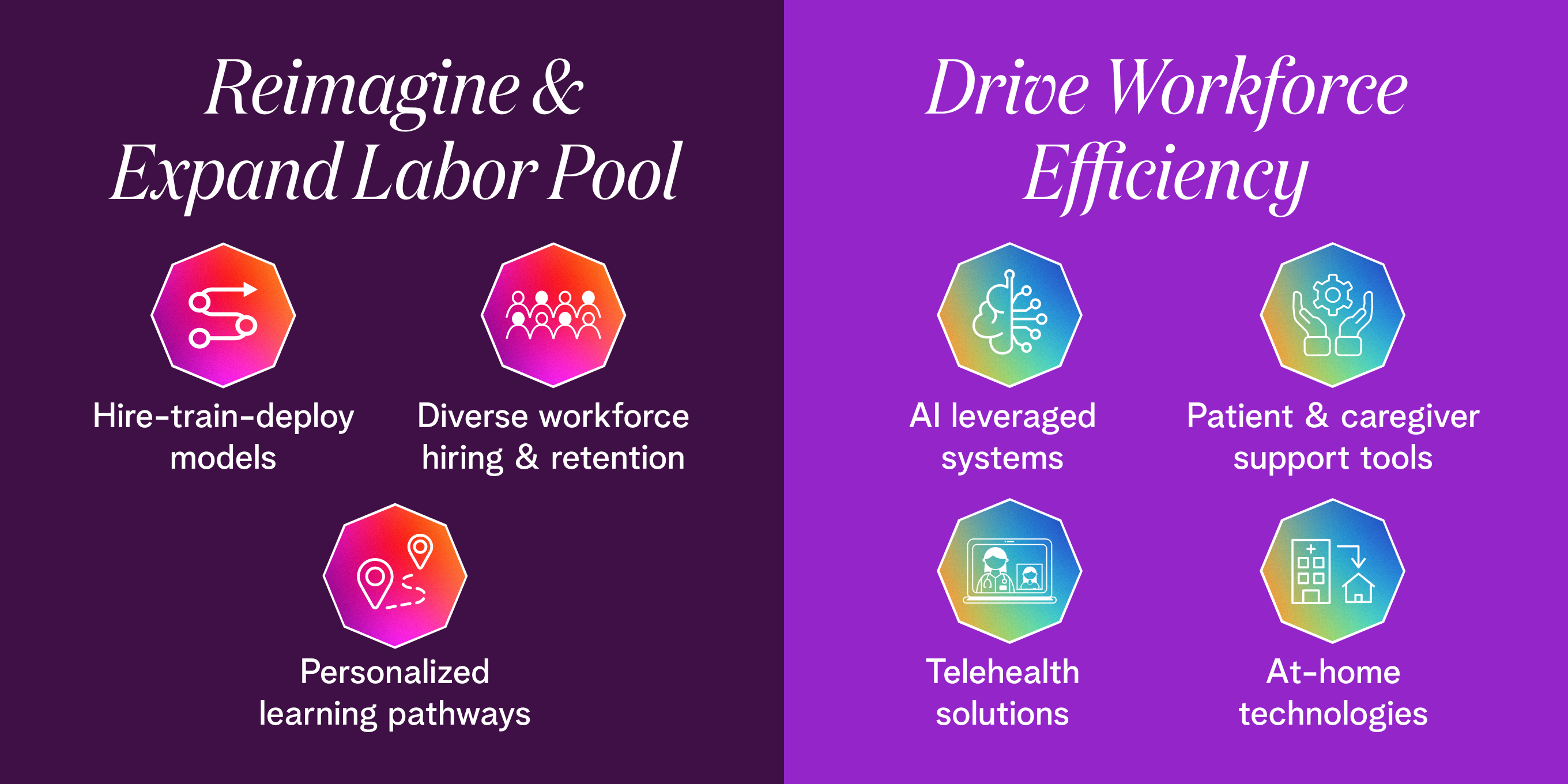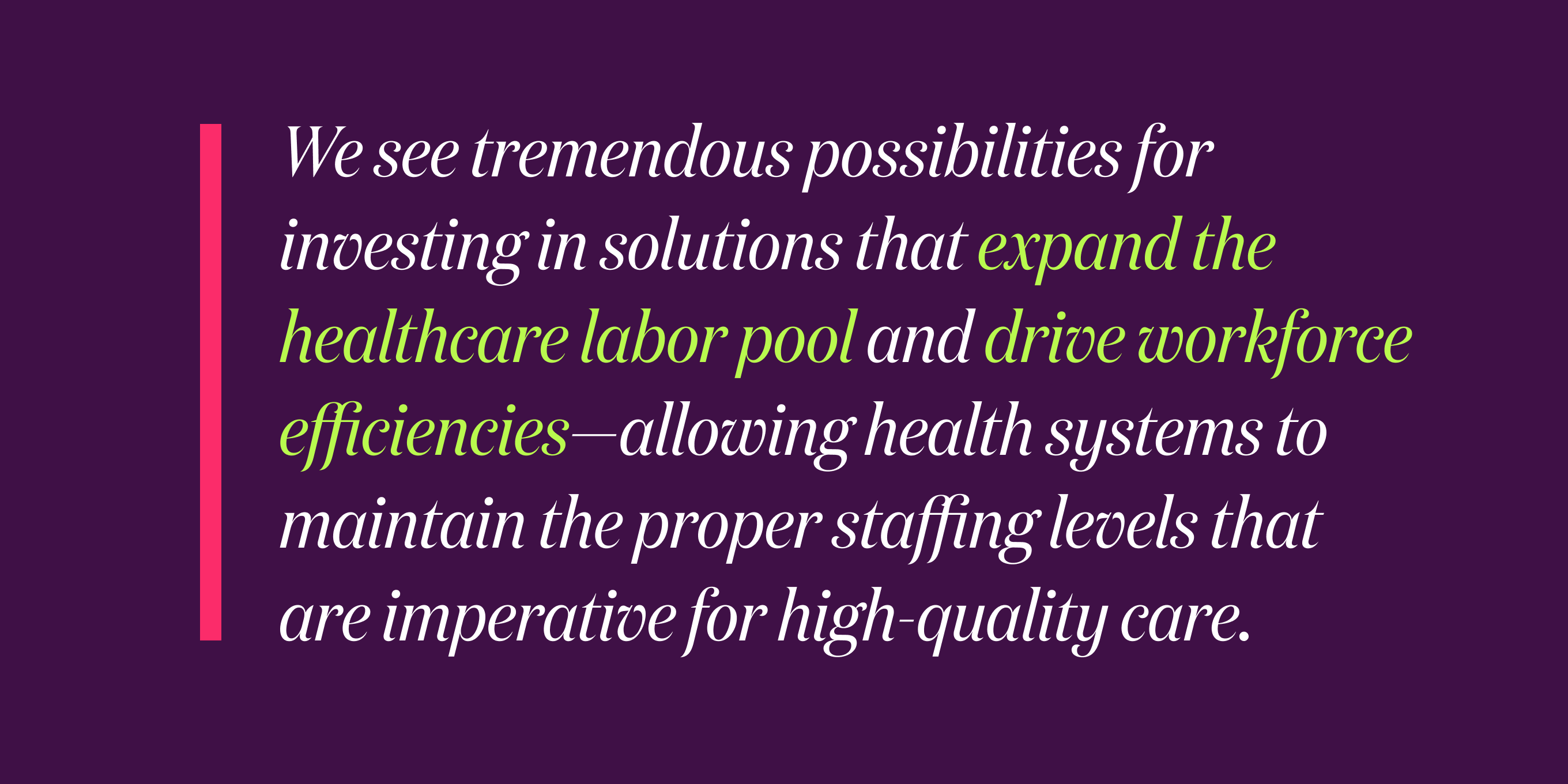
Reimagining the Healthcare Labor Pool Through Innovation
The historic talent shortage facing healthcare organizations won’t get better anytime soon. A combination of demographic shifts and increased pressures on workers post-pandemic are creating a tsunami that is reducing the supply of available healthcare professionals rapidly.
The timing couldn’t be worse, with recent trends showing an increased demand for care. Without radical innovation, the labor shortage will only worsen over the next decade, with devastating impacts on patient access and outcomes.
These market forces offer an opportunity to build technology solutions that enable health systems to leverage their resources as effectively as possible across staff retention, recruitment, onboarding, training and documentation.

Trends causing the imbalance of supply and demand
According to the Bureau of Labor Statistics, openings in healthcare occupations are expected to grow by 15% from 2019 to 2029, much faster than the average for all occupations. However, current labor trends make it unlikely that there will be a sufficient pool of available talent large enough to fill these roles.
The resulting staffing gaps will cut across nearly all occupations. The Association of American Medical Colleges estimates that the total physician shortage will range from 38,000 to 124,000 professionals by 2034. Similarly, experts predict a shortage of 160,000 registered nurses and licensed practical nurses by 2030.
Trends driving the staffing shortfalls include:
An aging clinician workforce. Nearly 45% of doctors are older than age 55, and more than 40% of active physicians will be 65 or older in the next 10 years. Nearly 40% of RNs are over age 50.
Burnout and stress. Levels of burnout continue to rise, with physician burnout reaching a record 53% in 2023. Furthermore, some 900,000 RNs are expected to permanently leave their roles if workplace-related stressors aren’t alleviated.
Insufficient educational capacity. Medical schools, nursing schools and residency programs struggle to meet the growing demand for new healthcare professionals and turn away many prospective students.
Geographic disparities. Rural and underserved areas often lack healthcare professionals, as many prefer to practice in urban or suburban settings.

Simultaneously, these trends are driving increased healthcare demand and utilization:
An aging U.S. population. The number of people over age 65 in the U.S. is expected to double between 2000 and 2030. These individuals account for twice as many physician visits as people under age 65. They also experience far higher rates of cancer and other conditions that require high-intensity clinical care.
Site of care shifts. As healthcare expands into virtual modalities, outpatient settings, home care and schools, the competition for services and labor grows more intense.
Clinical and technological innovation. Advances in medicine create promising new treatment modalities. But deploying and managing each one effectively requires additional clinical labor. At the same time, a rise in healthcare startups and the proliferation of nontraditional bedside roles is spreading the existing talent pool even thinner.
How innovation can balance healthcare labor supply and demand
To solve the industry’s labor shortage, we believe innovation must focus on two areas:
1. The healthcare labor pool must be reimagined and expanded. This will require innovation to happen on two fronts:
Upleveling, or pushing providers to operate at the top of their licenses and/or giving them the time they need to focus on complex work
Expanding care teams to include new provider types, such as health coaches, complementary and alternative (CAM) providers, and lower-skilled specialists capable of managing specific patient populations
2. Stakeholders must prioritize staff augmentation and support while optimizing and streamlining workflows. This renewed emphasis on increasing clinical workforce productivity and decision-making is crucial to reduce healthcare providers’ administrative burden, increase time spent at the bedside with patients and invest in the well-being of healthcare professionals.
Developing solutions to meet these two challenges head-on
Redesign Health is committed to developing a broad range of Operating Companies that will help organizations tackle the healthcare shortage and mitigate its impacts on patient care.
To reimagine and expand the healthcare labor pool, we are focusing on:
Hire-train-deploy models to rapidly increase the supply of clinical labor in categories that require less intensive training and certification. Doing so will help bring relief to clinicians with more advanced training.
Solutions to attract and retain a diverse workforce that create pipelines for underrepresented groups. The benefits of this approach are twofold: increasing clinical labor supply while also addressing health disparities by engaging patients with a more diverse clinical workforce.
Data-driven personalized learning pathways and competency documentation tied to individual career trajectories and health system demand. These solutions will fill clinical gaps and reduce turnover.
To drive workforce augmentation and efficiency forward, we are focusing on:
Systems and processes, particularly leveraging generative AI, that will reduce clinicians’ administrative tasks and free up their time and mental energy for the direct provision of patient care.
Decision support tools that enable faster, more accurate and more patient-centric clinical interventions, up to and including care delivered by informal caregivers, community organizations and even patients themselves.
Telemedicine and remote patient monitoring solutions that increase clinical workforce productivity while enabling care access in areas with clinician labor shortages.
Technologies to support the unique challenges of delivering care at home.

Due to the acuity of the current supply-and-demand imbalance, healthcare stakeholders are already spending a lot of money triaging upstream issues such as employee recruitment and retention, and this will remain a priority for years to come.
That said, we believe the second wave of innovation will see companies addressing downstream issues, such as training and clinical skill development for newly matriculated nurses who are transitioning to bedside care.
Our research suggests that the average level of experience of a 12-hour bedside nurse has fallen from about seven years pre-pandemic to three years today, raising the risk for medication errors and other adverse events. What’s more, a shortage of nurse preceptors means fewer staff are available to train these newer nurses. Therefore, great opportunity exists in building solutions that can help nurses with two to three years of experience close the knowledge gap efficiently and effectively.
Launching stealth companies to make a meaningful impact
We have built two exciting stealth Operating Companies that we believe will help providers, payers and ultimately patients by reimagining the healthcare talent pool and optimizing workforce efficiency.
StealthCo1 is an enablement platform for provider organizations that improves clinician workforce visibility, addresses turnover risk proactively, and mitigates the costs and disruption of turnover for revenue-generating professionals. This will help provider organizations prevent and manage clinician turnover, a problem that can cost $200,000 to $3 million per clinician. It will also help reduce internal and external stressors that are causing high rates of burnout and depression among clinicians.
StealthCo2 is a utilization management (UM) workflow automation solution designed to expedite and enhance the quality of UM determinations for health plans. While several existing solutions target efficiency at the point of a UM request submission, a sizable portion of reviews still require manual intervention. This solution is poised to transform the space by centralizing and synthesizing disparate data sources to improve the speed, quality and overall efficiency of clinical determinations.
Compiling an ecosystem of solutions to mitigate staff shortages
These two stealth companies join an existing ecosystem of successful Operating Companies developed by Redesign Health to address critical staffing shortages. These companies run the gamut of staffing, practice outsourcing, staff augmentation and decision support:

Final thoughts
Sticking to the status quo will not get health systems out of the staffing crisis. It’s time for radical innovation. We see tremendous possibilities for investing in solutions that expand the healthcare labor pool and drive workforce efficiencies—allowing health systems to maintain the proper staffing levels that are imperative for high-quality care.

![No alternate text]() Redesign HealthDemystifying Healthcare Innovation: 4 Lessons on Driving Meaningful Change
Redesign HealthDemystifying Healthcare Innovation: 4 Lessons on Driving Meaningful ChangeInnovation is a frequently used buzzword in healthcare. Despite its widespread usage within our industry, achieving tangible value and impactful outcomes often proves challenging.
April 16, 2024
![No alternate text]() Healthcare TrendsRedesign Health2024 Health Trends: 4 Experts Discuss Key Innovation Priorities
Healthcare TrendsRedesign Health2024 Health Trends: 4 Experts Discuss Key Innovation PrioritiesTo uncover the most pressing healthcare issues—and possible solutions—on the horizon for 2024, our team polled four influential industry thought leaders and Executive Advisory Board members at Redesign Health.
January 10, 2024
![No alternate text]() MedicaidModernizing Medicaid with a Multi-Stakeholder Financing Model
MedicaidModernizing Medicaid with a Multi-Stakeholder Financing ModelDiscover how a multi-stakeholder financing model could overcome some of Medicaid’s obstacles, dramatically improving health and quality of life outcomes for Medicaid recipients while generating savings across government programs.
November 15, 2023
![No alternate text]() Chronic CareRedesign HealthWraparound Care: The Next Frontier in Chronic Care Management
Chronic CareRedesign HealthWraparound Care: The Next Frontier in Chronic Care ManagementExploring tech-infused strategies to manage chronic conditions
September 05, 2023
![No alternate text]() ADVISORSRedesign HealthRedesign Health Advise: Leveraging Experts and Insights to Expand Impact
ADVISORSRedesign HealthRedesign Health Advise: Leveraging Experts and Insights to Expand ImpactThe Redesign Health Advise program connects our team and founders with a deep bench of experts from across the healthcare industry.
June 29, 2023
![No alternate text]() Senior HealthRedesign HealthInvesting in AgeTech: Serving the Growing Senior Health Market
Senior HealthRedesign HealthInvesting in AgeTech: Serving the Growing Senior Health MarketProviding targeted tech solutions for aging adults
June 14, 2023
![No alternate text]() Shifting Sites of Patient Care: Driving Value in Alternative Settings
Shifting Sites of Patient Care: Driving Value in Alternative SettingsRight care, right setting: Unlocking value in alternative sites of care
April 27, 2023
![No alternate text]() Value-Based CareThe Evolution of Value-Based Care: Exploring Challenges and Opportunities in Adoption
Value-Based CareThe Evolution of Value-Based Care: Exploring Challenges and Opportunities in AdoptionRedesign Health Venture Chair Missy Krasner recently hosted a roundtable discussion with leaders in the Value-Based Care Industry to explore how the adoption of value-based care is unfolding--and what to expect in the coming years.
February 15, 2023
![No alternate text]() James QuarlesThe Kids Aren’t Alright: Addressing the Adolescent Mental Health Crisis With Accessible, High Quality, Evidence-Based Practice
James QuarlesThe Kids Aren’t Alright: Addressing the Adolescent Mental Health Crisis With Accessible, High Quality, Evidence-Based PracticeResearch shows that mental health disorders have surpassed physical conditions as the most common causes of impairments and limitations in children. Suicide was the second-leading cause of death among 10 to 14 year-olds in 2020.
February 15, 2023
![No alternate text]() PartnershipsRedesign HealthPartnering with Leading Health Systems to Drive Change and Improve Outcomes
PartnershipsRedesign HealthPartnering with Leading Health Systems to Drive Change and Improve OutcomesAt Redesign Health, we firmly believe the US healthcare system desperately needs innovation to address our lagging health outcomes, sky-high costs and uneven access to care.
February 09, 2023
![No alternate text]() Platform, Company CreationBehind the Curtain: Redesign Health's Company Creation Process
Platform, Company CreationBehind the Curtain: Redesign Health's Company Creation ProcessIt's easy to say healthcare is broken. It's much harder to fix it. At Redesign Health, we’re up for the challenge.
February 01, 2023
![No alternate text]() Healthcare TrendsHealthcare’s Biggest Trends in 2023: Industry Forecast from Redesign Health
Healthcare TrendsHealthcare’s Biggest Trends in 2023: Industry Forecast from Redesign HealthPowering healthcare innovation at scale is the heart of our work at Redesign Health. With 2023 on the horizon, we surveyed our cross-functional team of industry leaders for their forecast for 2023’s biggest trends in healthcare.
December 15, 2022
![No alternate text]() Insights from the Redesign Health Ecosystem: Improving Healthcare for Older Adults
Insights from the Redesign Health Ecosystem: Improving Healthcare for Older AdultsRedesign Health Venture Chair Missy Krasner recently hosted a roundtable discussion with leaders from three of our Operating Companies to explore the state of older adult healthcare in the U.S. and how their teams are facilitating healthier aging.
October 21, 2022
![No alternate text]() ResearchRedesign HealthStuck in the Middle: Healthcare Solutions for Older Adults Shouldn’t Be One Size Fits All. Here's Why.
ResearchRedesign HealthStuck in the Middle: Healthcare Solutions for Older Adults Shouldn’t Be One Size Fits All. Here's Why.There will be more older adults than children in America by 2035. We are not ready. A one-size-fits-all approach to older adult healthcare simply won’t be able to comprehensively support the needs of so many aging people.
October 05, 2022
![No alternate text]() Company CultureRedesigning Company Culture
Company CultureRedesigning Company CultureWe have big ambitions at Redesign Health: to make humanity healthier and to redesign healthcare for everyone. We strive to do things differently here, and building our company culture is no exception.
July 18, 2022














